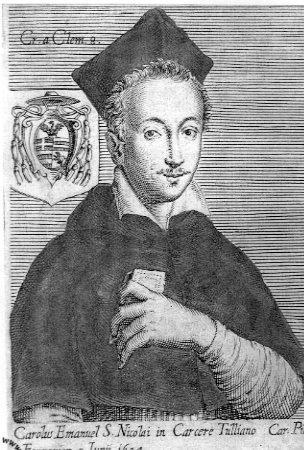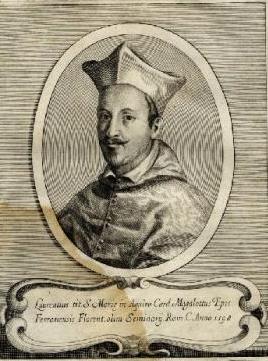Related Research Articles

The Diocese of Viterbo is a Latin Church ecclesiastical territory or diocese of the Catholic Church in central Italy. From the 12th century, the official name of the diocese was the Diocese of Viterbo e Tuscania. In 1986, several dioceses were combined, and the title was changed to "Diocese of Viterbo, Acquapendente, Bagnoregio, Montefiascone, Tuscania and San Martino al Monte Cimino"; in 1991 the name was shortened to "Diocese of Viterbo".

Francesco Maria Brancaccio was an Italian Catholic cardinal.

Guido Ascanio Sforza di Santa Fiora was an Italian cardinal, known also as The cardinal of Santa Fiora.

Carlo Emanuele Pio di Savoia was an Italian cardinal of the Pio di Savoia family. He was the uncle of Cardinal Carlo Pio di Savoia.

Mario Theodoli was an Italian Catholic Cardinal.

The basilica of Santi Cosma e Damiano is a titular church in Rome, Italy. The lower portion of the building is accessible through the Roman Forum and incorporates original Roman buildings, but the entrance to the upper level is outside the Forum. The circular building located at the entrance of the Forum, which now houses a small archeological exhibit, was possibly built in the early 4th century as a Roman temple which may have been dedicated to Valerius Romulus, deified son of the emperor Maxentius. The main building was perhaps the library of an imperial forum.

Giuliano Cesarini the Younger was an Italian Catholic prelate and cardinal.
Diego Sersale was a Roman Catholic prelate who served as Archdiocese of Bari-Canosa (1638–1665).
Alessandro Crescenzi, C.R.S. was a Roman Catholic cardinal who served as Camerlengo of the Sacred College of Cardinals (1685–1688), Archbishop of Recanati e Loreto (1676–1682), Titular Patriarch of Alexandria (1671–1676), Bishop of Bitonto (1652–1668), Bishop of Ortona a Mare e Campli (1644–1652), and Bishop of Termoli (1643–1644).

Lorenzo Magalotti was an Italian clergyman who was Cardinal Secretary of State under Pope Urban VIII from 1623 to 1628, and later Bishop of Ferrara till his death.
Ludovigo Galbiati or Ludovicus Galbiati was a Roman Catholic prelate who served as Bishop of Acerno (1637–1638).
Angelo Cesi was a Roman Catholic prelate who served as Bishop of Rimini (1627–1646) and Apostolic Nuncio to Venice (1645–1646).
Marco Antonio Mandosio or Marco Antonio Mondosio (1606–1638) was a Roman Catholic prelate who served as Bishop of Nicastro (1637–1638).
Giulio Diotallevi was a Roman Catholic prelate who served as Bishop of Strongoli (1637–1638).
Stefano Sauli was a Roman Catholic prelate who served as Archbishop of Chieti (1638–1649).
Enea di Cesare Spennazzi was a Roman Catholic prelate who served as Bishop of Ferentino (1644–1658) and Bishop of Sovana (1638–1644).
Antonio Celli, O.P. was a Roman Catholic prelate who served as Bishop of Isola (1641–1645).

Cesarini is an Italian surname and the name of an Italian noble family. Notable people mostly include members of the noble Cesarini family, who held various ecclesiastical titles.
Fabrizio Suardi or Alessandro Suardi was a Roman Catholic prelate who served as Bishop of Caserta (1637–1638) and Bishop of Lucera (1619–1637).
Benedetto Landi (1578–1638) was a Catholic prelate who served as Bishop of Fossombrone (1628–1632).
References
- 1 2 3 4 5 6 7 8 9 10 11 12 13 14 Miranda, Salvador. "CESARINI, iuniore, Alessandro (1592-1644)". The Cardinals of the Holy Roman Church. Florida International University. OCLC 53276621.
- 1 2 3 4 5 6 7 8 9 10 Cheney, David M. "Alessandro Cardinal Cesarini (Jr.)". Catholic-Hierarchy.org . Retrieved June 16, 2018. [self-published]
- 1 2 3 4 5 6 7 8 Chow, Gabriel. "Cardinal Alessandro Cesarini". GCatholic.org. Retrieved June 16, 2018. [self-published]